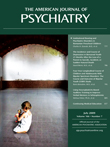In This Issue
Depression in Youth After Parent’s Death
The rate of depression was 10% in children, adolescents, and young adults 21 months after the death of a parent, compared to 2% in nonbereaved comparison subjects. Depression at 21 months was most strongly related to depression at the 9-month follow-up conducted previously by Brent et al. (p. Original article: 786 ). Depression during the second year after the loss was associated with parental death by suicide, loss of a mother, severe grief reaction, negative coping strategies, low self-esteem, and blaming others for the parent’s death. Subjects whose parent died by suicide also had a higher rate of alcohol or substance abuse than nonbereaved subjects. Dr. Katherine Shear clarifies grief and depression in an editorial on p. Original article: 746 .

Institutional Care of Preschool Children
Romanian children living in institutions who were randomly assigned to foster care at age 6–30 months were only half as likely to develop anxiety or other inward-focused psychiatric disorders as children who remained in the institutions. Both groups had higher rates of psychiatric disorders than noninstitutionalized children at 4.5 years of age. Zeanah et al. (CME, p. Original article: 777 ) also found gender-related differences. Only girls had better outcomes in foster care than in the institutions, and boys in both settings had higher rates of anxiety, depression, ADHD, and oppositional defiant or conduct disorder than girls. Dr. Franklin Miller examines ethical aspects of this research in an editorial on p. Original article: 743 .
Auditory Training for Schizophrenia
Computerized training in auditory discrimination and verbal learning led to greater cognitive gains in patients with schizophrenia than did computer games. Fisher et al. (p. Original article: 805 ) based their program on research suggesting that efficient auditory processing is crucial to encoding and retrieving verbal information. Patients participated up to 50 hours over the 10-week study. The exercises progressed in difficulty but adjusted to the user’s performance to maintain an 85% accuracy rate. The patients who received the training had greater gains in overall cognition and in verbal working memory, verbal learning, and verbal memory than those who were assigned to computer games. An editorial by Dr. Michael Green on p. Original article: 749 focuses on this study.
Post-Recovery Symptoms in Bipolar Youth
A 4-year follow-up of 413 children and adolescents with a bipolar episode demonstrated that most recovered but more than half had a recurrence. Birmaher et al. (p. Original article: 795 ) also report that symptoms were present more than half the time on average. During the follow-up, 25% of the bipolar II cases converted to bipolar I and 38% of the diagnoses of bipolar disorder not otherwise specified converted to bipolar I or II. Early onset, long duration, low socioeconomic status, and family history of mood disorders were associated with poorer outcomes.
Glutamate Receptors in Schizophrenia
Two receptors for the neurotransmitter glutamate that were previously implicated in schizophrenia jointly have now been differentiated in post-mortem brain tissue. Using receptor-specific antibodies, Ghose et al. (p. Original article: 812 ) detected lower levels of metabotropic glutamate receptor 3 (mGluR3), but not mGluR2, in the dorsolateral prefrontal cortex of patients with schizophrenia than in comparison subjects. The patients also had higher levels of glutamate carboxypeptidase II, an enzyme that metabolizes an endogenous mGluR3 agonist. Drs. Barbara Wroblewska and David Lewis discuss glutamate neurotransmission in an editorial on p. Original article: 753 .



